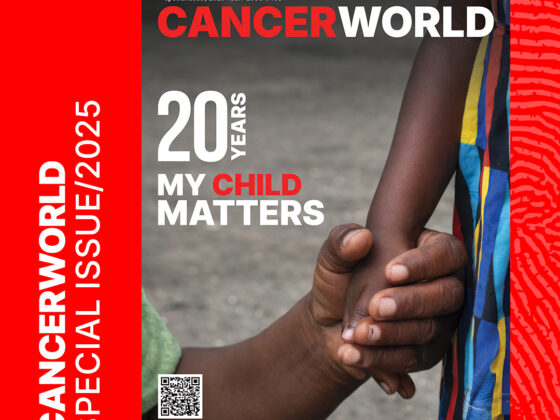Women who experience primary ovarian insufficiency (menopause before the age of 40) are more than twice as likely to experience breast cancer as other women of similar ages. The study, published in the Journal of Clinical Endocrinology and Metabolism, 12 July, also showed that in second-degree relatives (grandparents, aunts/uncles, nieces/nephews, half-siblings, and grandchildren), the risk of breast cancer was increased by 28% and the risk of colon cancer by 50%. Furthermore, the study found the risk of prostate cancer was increased by 64% in first-degree relatives, 54% in second-degree relatives and 33% in third-degree relatives (great-grandparents, great-grandchildren, and first cousins).
“The study results are an important message to women with primary ovarian insufficiency and early menopause to do regular breast screening and if they have cancer in their family they should be getting genetic tests for their cancer risk,” Corrine Welt, the corresponding author tells Cancerworld.
Commenting on the findings of raised risk of various cancers in second- and third-degree relatives, co-author Nicola Camp, a cancer genetic epidemiologist at Huntsman Cancer Institute (at the University of Utah), said, “This work has increased the understanding of the relationship between primary ovarian insufficiency and reproductive cancers, which could guide preventive strategies.”
Primary ovarian insufficiency (POI), where the ovaries stop working efficiently due to early loss of eggs, causes around 1% of women to go through menopause before the age of 40. Autoimmune causes, the fragile X gene and X chromosome deletions and translocations are known to account for some cases.
For the remainder, a study by Welt and colleagues published in 2022, which used next generation sequencing, demonstrated a candidate or causal gene for up to 43% of women. The study showed that approximately 50% of the deleterious gene variants causing POI were found in genes involved in meiosis, DNA damage repair and transcription, and translation fidelity. Prior studies have suggested that mutations in these genes can predispose people to cancer. The correlation prompted Welt and colleagues to investigate whether women with POI had a higher risk of cancer (especially reproductive cancers such as breast, ovarian and endometrial cancers) compared to the general population.
The team also explored early menopause (defined as affecting 5% of the population before the age of 45). “There are probably no medical differences between the two disorders, with overlap in the genetics. The genes affected may have more severe changes when menopause occurs before age 40 years or there may be more than one gene affected,” explains Welt, an endocrinologist from Spencer Fox Eccles School of Medicine at the University of Utah in Salt Lake City.
Using records covering 1995–2012 from the Utah Population Database – a multisource database housed at the Huntsman Cancer Institute with more than one billion health-related records – Welt and colleagues identified 613 women with POI (diagnosed <40 years) and 165 with early menopause (between 40 and 45 years). “Utah is the only location in the United States that has a genealogy database that encompasses the entire state,” explains Welt.
Individuals were then cross-referenced with the Utah Cancer Registry, which tracks cancer incidence and deaths in the state. Using the Utah Population Database, 2,405 first-degree relatives were identified, 6,798 second-degree relatives, and 17,666 third-degree relatives. The relative risk of cancer in women with POI and their relatives was then estimated by comparison to known population risk rates.
Results showed that breast cancer was increased in women with POI (OR=2.20; 95%CI 1.30–3.47; P=0.0023), and that there was a nominally significant increase in ovarian cancer.
Among second-degree relatives, there was an increased risk of breast cancer (OR=1.28; 95%CI 1.08–1.52; P=0.0078) and of colon cancer (OR=1.50; 95%CI 1.14–1.94; P=0.0036).
The risk of prostate cancer was increased in first-degree relatives (OR=1.64; 95%CI 1.18–2.23; P=0.0026), second-degree relatives (OR=1.54; 95%CI 1.32–1.79; P<0.001), and third-degree relatives (OR=1.33; 95%CI 1.20–1.48; P<0.001).
When investigators added 165 women with early menopause to the 613 women with POI, in the resulting 778 women the risk of breast cancer remained significant, with 23 observed versus 12.5 expected breast cancer cases (OR=1.89; 95%CI 1.20–2.84; P=0.0056). Ovarian cancer risk was also nominally significant (OR=3.38; 95%CI 1.15–8.65; P=0.032).
To explore the links between early menopause and cancer, six subjects who had DNA available underwent whole genome sequencing. Results showed that two of the women had frameshift variants – one in RAD51D (p.His250ThrfsTer2) and one in MORC2 (p.Leu67PhefsTer3) – and one woman had a stop-gain and missense variant in FANCM (p.Gln1701Ter and p.Gly546Ser). From this, the authors believe that the same genes are causing both conditions.
“Our data suggest that a subset of women with POI need counselling regarding future cancer risk. Recommendations will likely depend on underlying family history and genetic risk,” write the authors.
Doctors treating women with early menopause or POI should obtain a family history of cancer. “A good family history is free and would target the women who are most at risk for cancer,” suggests Welt.
Relatives of women with POI and early menopause, she adds, should be aware of their own menopause age and family cancer history. “The women should be screened for breast cancer and the men for prostate cancer as early and frequently as the guidelines recommend,” says Welt.
For women who have POI or early menopause caused by potential cancer risk genes, write the authors, the current practice recommending hormone replacement therapy until the average age of menopause should be reconsidered.
Next, the team plan to explore where there is a connection between POI and early menopause in other cancers. “We will look at the underlying genes causing cancer and POI/ early menopause to see if they are the same. We will also create a tool for women with POI/ early menopause to predict the other diseases they may be at risk for,” says Welt.












